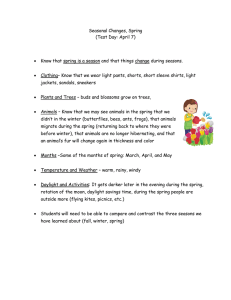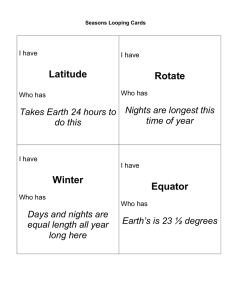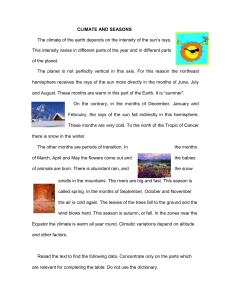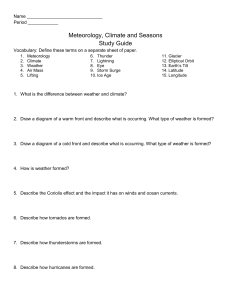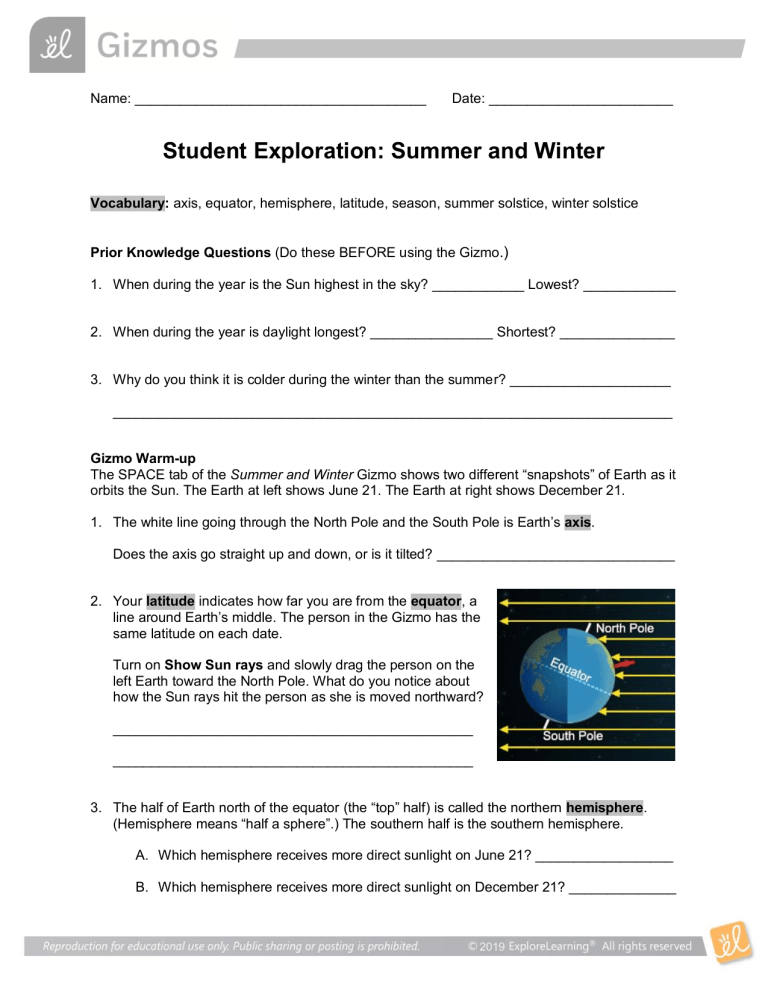
Name: ______________________________________ Date: ________________________ Student Exploration: Summer and Winter Vocabulary: axis, equator, hemisphere, latitude, season, summer solstice, winter solstice Prior Knowledge Questions (Do these BEFORE using the Gizmo.) 1. When during the year is the Sun highest in the sky? ____________ Lowest? ____________ 2. When during the year is daylight longest? ________________ Shortest? _______________ 3. Why do you think it is colder during the winter than the summer? _____________________ _________________________________________________________________________ Gizmo Warm-up The SPACE tab of the Summer and Winter Gizmo shows two different “snapshots” of Earth as it orbits the Sun. The Earth at left shows June 21. The Earth at right shows December 21. 1. The white line going through the North Pole and the South Pole is Earth’s axis. Does the axis go straight up and down, or is it tilted? _______________________________ 2. Your latitude indicates how far you are from the equator, a line around Earth’s middle. The person in the Gizmo has the same latitude on each date. Turn on Show Sun rays and slowly drag the person on the left Earth toward the North Pole. What do you notice about how the Sun rays hit the person as she is moved northward? _______________________________________________ _______________________________________________ 3. The half of Earth north of the equator (the “top” half) is called the northern hemisphere. (Hemisphere means “half a sphere”.) The southern half is the southern hemisphere. A. Which hemisphere receives more direct sunlight on June 21? __________________ B. Which hemisphere receives more direct sunlight on December 21? ______________ 2019 Activity A: Reasons for seasons Get the Gizmo ready: On the SPACE tab, drag the person to 40° N latitude. (This is the latitude of New York City.) Check that Show Sun rays is on. Introduction: A season is a major division of the year, based on regular weather changes. Most of the world has four seasons – winter, spring, summer, and autumn (fall). The summer solstice is the first day of summer. The winter solstice is the first day of winter. The solstice dates usually (but not always) fall on June 21 and December 21. Question: Why is it colder in winter than summer? 1. Form hypothesis: In the northern hemisphere, why do you think it is colder in December than in June? ______________________________________________________________ _________________________________________________________________________ 2. Collect data: Select the EARTH tab. Record the following data for the 40° N location: The number of Sun rays hitting the solar panel on June 21 and December 21. The temperature on each date. The June 21 hours of daylight and December 21 hours of daylight. The angle of the Sun’s rays on each date. (Turn on Show protractor.) Date Rays on panel Temp. (°C) Daylight hours Sun ray angle June 21 December 21 3. Analyze: Look at your data table. A. On which date are there more hours of daylight? ____________________________ B. On which date does more sunlight hit the solar panel? ________________________ C. How does the angle of sun rays relate to the temperature? ____________________ ___________________________________________________________________ 4. Draw conclusions: Why is it colder in winter than summer? Give two reasons. ___________ _________________________________________________________________________ _________________________________________________________________________ 2019 Get the Gizmo ready: Activity B: Southern seasons On the SPACE tab, drag the person latitude 40° S. (This is close to the latitude of Wellington, New Zealand.) Question: What are seasons like in the southern hemisphere? 1. Form hypothesis: Look at how the Sun rays hit the person in the southern hemisphere on June 21 and December 21. Which date do you think is warmer? Why? _________________________________________________________________________ _________________________________________________________________________ 2. Collect data: Select the EARTH tab. Fill in the information for the latitude 40° S, on June 21 and December 21. (To measure the Sun ray angle, select Show protractor. The angle will be between 0 and 90 degrees.) Date Rays on panel Temp. (°C) Daylight hours Sun ray angle June 21 December 21 3. Analyze: What is the first day of winter in the southern hemisphere? ___________________ What is the first day of summer in the southern hemisphere? ________________________ 4. Draw conclusions: How are seasons in the southern hemisphere related to seasons in the northern hemisphere? _______________________________________________________ _________________________________________________________________________ 5. Extend: On the SPACE tab, drag the axis to 0° (straight up and down). How does this affect seasons on the EARTH tab? __________________________________________________ 6. Apply: What would seasons be like if Earth’s axis were tilted more than 23.5°? ___________ _________________________________________________________________________ Use the Gizmo to test your prediction. Were you correct? ___________________________ 2019 Get the Gizmo ready: Activity C: Extreme seasons Click Reset tilt to change the axis tilt back to 23.5°. On the SPACE tab, drag the person to the North Pole (90° N). Question: What are seasons like at the poles and equator? 1. Collect data: Select the EARTH tab. Fill in the data for the North Pole, on June 21 and December 21. (To measure the Sun ray angle, select Show protractor.) Date Rays on panel Temp. (°C) Daylight hours Sun ray angle June 21 December 21 2. Analyze: What do you notice about the seasons on the North Pole? ___________________ _________________________________________________________________________ _________________________________________________________________________ 3. Collect data: Click on the SPACE tab, and drag the person to the equator (latitude 0°). Select the EARTH tab and fill in the data table for this location. Date Rays on panel Temp. (°C) Daylight hours Sun ray angle June 21 December 21 4. Analyze: What do you notice about the seasons on the equator? _____________________ _________________________________________________________________________ _________________________________________________________________________ 5. Draw conclusions: Describe what June 21 and December 21 would be like on the North Pole and the equator. _______________________________________________________ _________________________________________________________________________ _________________________________________________________________________ _________________________________________________________________________ 2019
